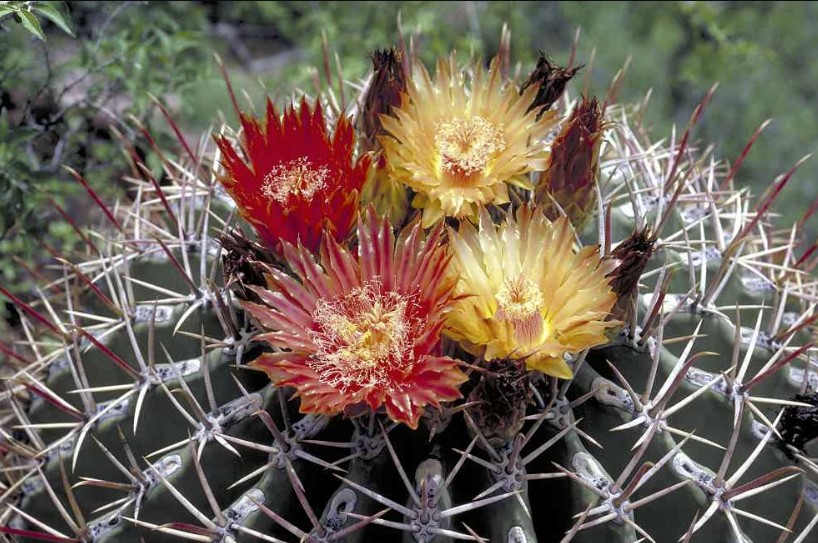Family: Ferocactus emoryi is a species of the family Cactaceae in the order Caryophyllales.
Genus: It is a barrel cactus in the genus Ferocactus.
Habitat: Ferocactus emoryi is solitary, globose to cylindrical, light to glaucous green, 2.5 meters (8.2 feet) high, and 1 meter (3.3 feet) in diameter. The plant thrives on rocky slopes, hillsides, gravely rocky or sandy soils, and desert scrubs.
Seeds: black and 2 mm in diameter
Ribs: particularly when it is still a juvenile (15–30, sometimes more) with distinct tubercles.
Spines: The spines are whitish to reddish.
Central spine: very stout, flattened, straight, curved, or hooked, 4–10 cm (1.6–3.9 inches) long. Usually, the longest spines of any cactus.
Radial spines. About 7-9 to 6 cm (2.4 inches) long.
Areoles: Usually oval with brown wool, 2–2.5 cm apart.
Flowers: Ferocactus emoryi flowers are broadly funnelform, mahogany, red, red-tinged with yellow, or yellow, to 7.5 cm (3 inches) long and 5-7 cm (2–2.8 in) in diameter. The stigma lobes are vibrant red. It is possible that this plant is a somatic chimera, with the left half always producing red flowers and the right half producing yellow flowers.
Fruits: The fruits are obovoid to oblong, to 5 cm (2 inches) long, not dehiscing by basal pores. Frequently, birds or rodents break into the fruit and consume the seeds.
Distribution: Ferocactus emoryi is found in nature in southern central Arizona (Yuma, Pima, and Maricopa Co.) and Sonora, Sinaloa, and Baja California Sur, Mexico.
Elevation: About 0–1,200 meters (0–3,937 feet) above sea level.
Usage: Ferocactus emoryi is used for medical purposes for the Seri, and spines have been used in making face paint (under Cacti as Medicine and Cacti as a Source of Dyes).
Subspecies: There are two subspecies of F. emoryi recognized.
-
Subspecies emoryi has stems up to 2.5 m (8.2 feet) high and 1 meter (3.3 feet) in diameter, with 30 or more ribs. It occurs in southwestern Arizona, south into Sonora, and northern Sinaloa.
-
Subspecies rectispinus has much smaller stems, usually no more than 1.5m (4.9 feet) high and 45 cm (18 inches) in diameter, and usually about 21 ribs. It occurs only in northern Baja California Sur.
Other names: also known as Emory’s barrel cactus, Coville’s barrel cactus, and traveler’s friend.
Flowering Seasons: On Cerro Las Avispas, this amazing plant was discovered blooming in July. Initially, it could be assumed that the flowers open one color and age to the other. However, the two red flowers on the left side of the plant are young (upper) and old, and the same is true of the two yellow flowers (the older one is upper).
Flowers Life Span: The flowers last two to three days.
Comments: Ferocactus emoryi produces nectar in the nectaries at the top of the cactus, which feeds the ants that surround its base. Being fiercely protective of their territory, the ants seem to protect the plants from other insects that might try to walk up the stem and damage the developing apex of the stem’s new, delicate cells or take pollen or nectar from the flowers. This strategy is supportive of both protecting the plant from small herbivores and boosting outcrossing pollination.
Status: The plant is widely distributed, shows no signs of a systematic decline, and is found in many protected places. However, land use change—primarily from ranching—has previously resulted in distribution reductions for the plant.
Synonyms: Echinocactus emoryi Engelmann 1856; Echinocactus emoryi; rectispinus Engelmann 1896; Ferocactus rectispinus (Engelmann) Britton & Rose 1922; F. emoryi var. rectispinus (Engelmann) N. P. Taylor 1984; F. emoryi subsp. Rectispinus (Engelmann) N. P. Taylor 1998; Ferocactus covillei Britton & Rose 1922.
Read More: Turbinicarpus knuthianus: A Masterclass in Cactus Elegance







